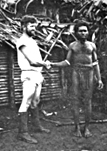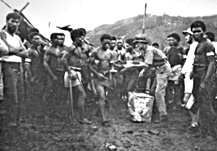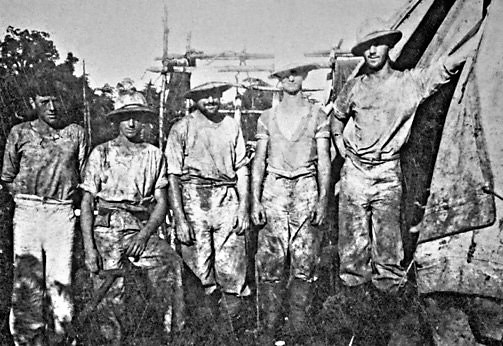The following is a chapter from the biography of Harvey Wilmot, ‘I’ll tell the world’ written by his son Jeff Wilmot. Harvey Wilmot served as a telegraphist in the Royal; Australian Navy from 1919 to 1929 and from 1939 to 1945. He served in HMAS Tingira and HMAS Adelaide during its 1923 -24 world cruise and its expedition to Malaita in 1927, HMAS Sydney during the Royal Tour of 1927, HMAS Bathurst and others between long periods on Garden Island.
In the Solomon Islands on 4 October 1927, District Officer William Bell, Cadet Kenneth Lillies and 15 native police were murdered at Sinalagu on the island of Malaita while collecting taxes.
The Solomon Islands was a British Protectorate, and in accordance with their common practice the British required the natives to pay for their own protection by taxing them, and gaoled them if they didn’t pay. So, they had to work on plantations or in the copra industry, or if they couldn’t or wouldn’t they had to sell their shell money for cash. There was resentment at having to pay money for no apparent return, particularly among the Kwaio people of the Malaitan mountains who for decades had held the Government in contempt and had a culture of murder, not only for retribution but also for bounties. District Officer Bell had been successful in bringing Malaitans generally under control but now he was confronting the Kwaio people and demanding not only that they pay the tax but they hand in their guns, which led to the murders by two hundred warriors led by a man called Basiana.
Initially believing that a general rebellion had started, the Resident Commissioner called for volunteers from the white population to assist the civil police to arrest the perpetrators of the “outrage” and asked Britain for a naval force to stiffen the base camps of a punitive expedition and, if necessary, shell villages. The British Government passed the request on to the Australian Government for assistance to demonstrate to the natives that their law must be obeyed.
Within hours of the request, on 10 October HMAS Adelaide was loaded with stores and arms at Garden Island and was on its way, the Captain having been instructed that if there was to be any shelling, warning should be given to avoid injury to innocent parties. Four days later the fleet collier, HMAS Biloela departed from Sydney loaded with coal, oil, tons of barbed wire and 20 navy volunteers including two leading telegraphists, one of whom was Harvey, and two other telegraphists.
The public supported the despatch of the warships. From the Sun News Pictorial of 11 October:
[It] is a reminder that whenever trouble arises in any part of the Empire the King’s ships are ready at any moment to proceed to the spot and uphold the prestige of the white people…
No one who has not been in a distant and isolated British community, surrounded by hostile natives, can understand the intense feeling of relief engendered by the sight of the White Ensign appearing over the horizon…
Once again the Mother Country has called for assistance, and once again Australia has not been slow in answering the call.
After consultation with the Resident Commissioner in which it was agreed that the navy should set up a base camp at the site of the massacre on a spit of land called Gwee’abe at the bottom of a steep mountain slope, Adelaide arrived at Sinalagu on 16 October. Still there at Gwee’abe was the hut that had been built to collect the taxes, tax discs and weapons strewn around and over all the smell from the hastily buried bodies and hacked-off parts of the police. The bodies of Bell and Lillies had been removed immediately after the massacre and taken to the capital Tulagi. A platoon was landed that evening and next morning to clear the site and the hut was burned at 0800 on the 17th. The District Officer Colin Wilson enrolled 50 natives to help in clearing the ground and by next day the site was ready for the Civil force.
The next camp, towards the top of the hill and called Base ‘B’ was begun and occupied on the 21st. On the same day the Civil Force consisting of 55 police, 29 European volunteers and 62 bearers arrived at Sinalagu. Biloela arrived at Tulagi in the afternoon and stayed there until the Captain of Adelaide found out and ordered her to get to Sinalagu quickly. She sailed at 1300 on the 22nd and arrived at Sinalagu at 0800 on the 23rd. On the 24th reconnoitring began for a suitable site for Base ‘A’ some distance inland. It was decided to establish it about two hours march from the village of Basiana, the leader of the murderers, and the move there began on the 26th.
Communication between base camps and Adelaide was to be by wireless but until Biloela arrived the only set available was one built up by two Petty Officer Telegraphists out of parts they had purchased with their own funds before leaving Sydney. It was set up at Base ‘B’. Biloela brought four field W/T sets, some to be set up at Base ‘A’. Among the Civil and Police force, bluejackets (sailors) and hundreds of bearers trekking to the site to supply and man it, was Harvey to assist in putting the W/T sets to work.
On their return to Sydney the crew related their experience to the Sydney Morning Herald (25 November):
The thickly wooded and mountainous interior of the island made a rapid advance an utter impossibility. In places the scrub was well-nigh impenetrable. Thick vines and creepers hung from the trees, while dense tropical undergrowth rendered deviation from the narrow, winding native tracks impossible. Frequently, paths had to be hacked through the undergrowth. Thick brown mud, often knee-deep, further hindered progress. Scrambling up the precipitous sides of mountains, carrying heavy packs under alternatively a blazing sun or a tropical downpour resulted in sickness breaking out. The foetid atmosphere had serious effects upon the health of the sailors…
Each sailor was provided with a rug and ground sheet, and bell tents were supplied. The nights, as a rule, were bitterly cold, and further sickness developed as a result of the men lying on damp ground. Many discarded their rugs in the advance and were forced to sleep in their working dress. Ground bugs and mosquitoes were a constant nuisance and menace to the health. Their bites caused body sores which did not heal readily in the humid climate.
By 10 November two men at Base ‘A’ had malaria and ten had dysentery, one of whom was Harvey who told me he was “sort of sick”. They were returned to hospital on the Adelaide, some having to be carried.
After assisting in setting up another base at Gounaile, Basiana’s village, and building a prison compound at Gwee’abe there was no more to be done, and Adelaide left Sinalagu on 16 November to return to Sydney via Tulagi.
Having been disappointed at not being allowed to have free shooting at the ‘bush boys’ and having proved themselves to be, to quote Adelaide’s captain, a “useless and undisciplined crowd who ought never to be sent on the Expedition at all”, the European volunteers also withdrew, leaving the task of arresting the perpetrators to the native police, many of whom had relatives among the murdered and were out to avenge their deaths. At least 60 innocent people died, women were raped, taro gardens were poisoned, sacred sites and objects were desecrated and pigs were shot. Many of the original perpetrators were arrested, and others gave themselves up to prevent any further ruin. After trial six were hanged and many others sentenced to prison sentences, some for life.
When Adelaide arrived back at Sydney on 23 November, 20% of the men who had been ashore were admitted to the Prince of Wales hospital, fifteen with dysentery, five with malaria and eleven with abrasions and septic sores.
The press had its own view of the outcome of the expedition. From the ‘Truth’ of 30 November:
The cruiser Adelaide arrived back at Sydney last weekend from her trip to the Solomon Islands. Her mission was to protect the whites in Malaita and to punish the blacks who had shown more than usual activity in their favourite hobby of murder. But from what has leaked out she appears to have come away without completing her work, the chief result of her expedition being an outbreak of the horrible disease called “Solomon sores” amongst her crew. To leave a job of this sort undone, is… unlike the Australian way… The story runs that the whites [ie the volunteers discredited by Adelaide’s captain] said they would do the job themselves, as the Australian methods were only amusing the bushmen. Shade of the Anzacs!
Even discounting the distortions in that account, the expedition was not the Australian Navy’s finest action.
Further Reading
Swinden, Greg, HMAS Adelaide – Malaita Expedition 1927, Naval Historical Review June 1994 available at https://navyhistory.au/hmas-adelaide-malaita-expedition-1927/










